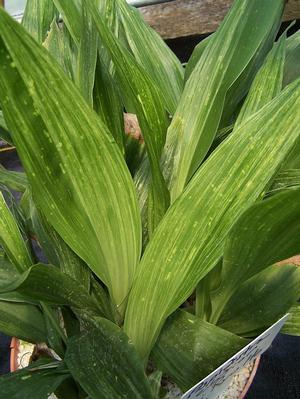View All Plants :: View All SHADE PERENNIALS :: View All TENDER PERENNIALS
Aspidistra elatior 'Sei Ryu Ho'
Cast Iron Plant
Plant Type:
SHADE PERENNIALSAspidistra elatior 'Sei Ryu Ho' (ex: Jonathan Lehrer) - This Japanese selection of Cast Iron Plant with just a touch of white streaks near the leaf tips is dotted up and down the dark, glossy green leaves. 'Sei Ryu Ho' which translates to "Green Dragon Hall" sports raised veins on each blade adding texture. The leaves are about 18 inches tall supported by 6 inch petioles. A nice selection. Pot grown division.
"And now for something completely different" - I mean technical: Jonathan had thought this to be an A. lurida selection. But Tony Avent, whose information, is about as... please excuse the pun... spot-on as it comes classifies 'Sei Ryu Ho' as A. elatior. And so, after a brief conversation with Jonathan after this arrived as A. lurida he gives the nod to Tony Avent's astute assignation.
Characteristics and Attributes for Aspidistra elatior 'Sei Ryu Ho'
Season of Interest (Flowering)
- Winter
Season of Interest (Foliage)
- Four Seasons
Light
- Morning Sun / Afternoon Shade
- Shade
- Dappled Shade
Attributes
- Ground Cover
- Greenhouse / Alpine House
- Foliage
- Massing
- Conservatory
- Drought Tolerant
- Edging
- Potted Plant
- Evergreen
- Woodland
Growth Rate in the Garden
- Medium
Soil
- Draining
- Fertile
- Woodland
Origins
- Garden Origin
Propagated By
- Division
Genus Overview: Aspidistra
Good old-fashioned Cast-Iron Plant is resurging in popularity as the tough garden denizen it is when located in even quite dense shade down south in USDA zones 7 to 10 or as a potted plant in the north. It is also possible they may exhibit greater northern hardiness according to Professor Jonathan Lehrer (into USDA zone 6) as it re-emerges in his Long Island garden. It would be worth seeking out Jonathan's sage article, From Cast-Iron to Gilded Gold, which appeared the June, 2011 issue of American Nurseryman. But let me offer one colorful quote right here, right now: "this herbaceous perennial from Japan has long been the butt of Western insult. It debuted as a tortured container plant in the dusty, drafty parlors of Victorian England and became a maligned icon of literature and song. A forgiving character, apsidistra sought refuge at the local pub only to serve admirably potted in a spittoon." ...Very cheeky, indeed.
The blade shaped leaves are glossy to semi-glossy on tough stems. Aspidistra is virtually evergreen down south sited outdoors and certainly evergreen as a potted plant in your vestibule up north. The flowers which occur at ground level or just below are akin to wine-maroon sea anemones with the "tentacles" becoming waxy opaque whitish at the tips. Flower color may vary somewhat from this descriptive. And though the flowers are perhaps not a Cast Iron Plant's most ornamental feature, hidden or otherwise they are nevertheless cool, odd curious and even luridly beguiling - one could say their season of flowers, generally during winter, offers a fascinating "Angry Red Planet" dimension... Okay, okay - some of us are easily amused.
If grown as a house plant filtered shade to early morning sun is adequate. Full sun behind nylon (or another gauzy material) curtains is excellent. Do not over water cast iron plant. If constantly wet it will rot. Water thoroughly but never let it sit in water. In winter keep them even drier. In late winter look for new growth tips shooting up above the soil. Check for the amazing flowers at this moment. Increase water at that time. But again it is imperative as a house plant that you let the plant go dry between waterings. A moderately good but draining soil/medium is best.
There are remarkably beautiful variegated color forms available and through the generous support of Jon we are offering some. Our plants are pot-grown divisions.


